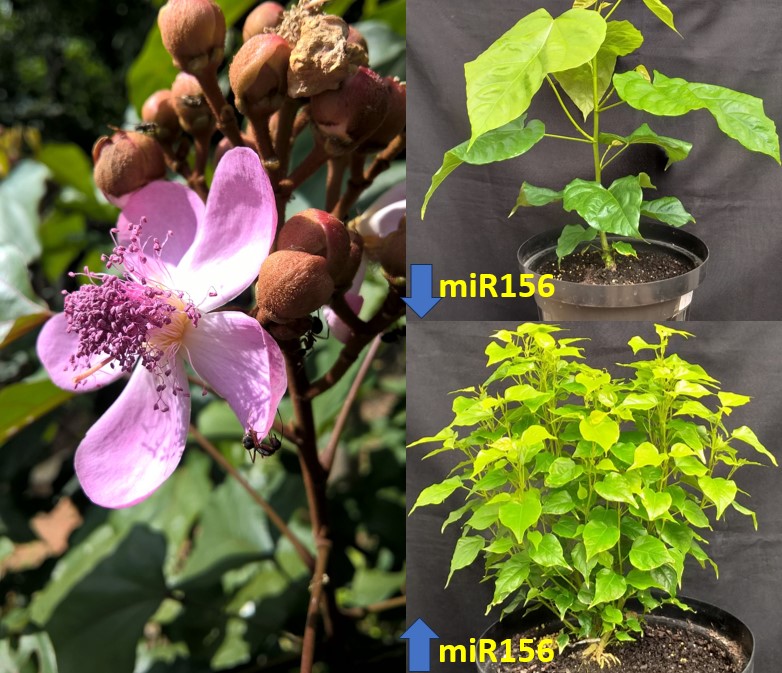

The study showed that a decline in production of microRNA 156 at the end of the juvenile phase coincides with a rise in production of the pigment (images: Fábio Tebaldi Silveira Nogueira/ESALQ-USP)
A study by Brazilian researchers shows that the pigment is present not only in the seeds but also in other organs of Bixa orellana, the Annatto tree. They investigated the genetic pathways involved in synthesis of the substance.
A study by Brazilian researchers shows that the pigment is present not only in the seeds but also in other organs of Bixa orellana, the Annatto tree. They investigated the genetic pathways involved in synthesis of the substance.

The study showed that a decline in production of microRNA 156 at the end of the juvenile phase coincides with a rise in production of the pigment (images: Fábio Tebaldi Silveira Nogueira/ESALQ-USP)
By Julia Moióli | Agência FAPESP – Researchers at the University of São Paulo’s Luiz de Queiroz College of Agriculture (ESALQ-USP) and the Federal University of Viçosa (UFV) in Brazil have shown for the first time that bixin or annatto powder, a carotenoid pigment extracted from the seeds of the achiote or annatto tree (Bixa orellana), is not produced only in the seeds but also in other organs, and that the process intensifies in the plant’s adult phase.
An article on the study published in the Journal of Experimental Botany, also describes genetic modifications in the species that can optimize production of the pigment, which is widely used in the food and beverage industries as a natural coloring agent, and in sunscreens as well as other medications and cosmetics.
Demand for the pigment has risen in recent years, as more consumers seek products with natural ingredients. According to data published in Revista Brasileira de Gestão e Desenvolvimento Regional, Brazil is the world’s largest producer of the pigment, with São Paulo state in the lead.
“The more we know about the anatomic and physiological characteristics of Brazil’s native species, especially those with economic importance, such as annatto, and the better we understand the genetic pathways involved in their development and the substances they produce, the more efficiently we’ll be able to manage them, which is essential in an era of climate change,” Fábio Tebaldi Silveira Nogueira, last author of the article, told Agência FAPESP. He is a researcher at ESALQ-USP’s Plant Development Molecular Genetic Laboratory.
In the study, which was partly funded by FAPESP, researchers belonging to Nogueira’s group and to UFV’s Plant Tissue Culture Laboratory, headed by Wagner Campos Otoni, analyzed pigment production during the plant’s development, focusing on the juvenile-to-adult phase transition, also known as the vegetative phase change. This is important because the annatto powder used in the food and drink industry is extracted from the seeds of the tree and yields have therefore always been assumed to be higher during the adult phase.
“We conducted tests in the lab to assess plants at different stages of development and found that production of annatto powder increases in the phase change and also in the leaves,” Nogueira said.
Genetic analysis
The researchers then set out to investigate the genetic and physiological pathways that are involved in changes in production of the pigment during the development of leaves, focusing on the pathway regulated by microRNA 156, known to be responsible for the juvenile-to-adult phase change in several other plants.
The researchers found that a decline in production of microRNA 156 at the end of the juvenile phase coincided with a rise in production of the pigment. The next step to validate this information in the annatto tree consisted of genetically modifying plants to overexpress microRNA 156. Anatomical, proteomic and statistical analysis confirmed the finding: the more microRNA 156 was produced, the more juvenile characteristics were observed in the plants, which took longer to transition to the adult phase. “Leaves that remain longer in the juvenile state have a different shape, with fewer channels to release the pigment,” Nogueira explained.
“With regard to molecular aspects, we found that several enzymes involved in the pigment production pathway were suppressed in the juvenile phase. However, we were particularly struck by the increased presence of the stress-related hormone abscisic acid [ABA]: because ABA and annatto powder share similar metabolic pathways, it’s as if the plant transferred part of the carbon it would use to make annatto powder to this other production line. If so, the process can be explained as due to the natural protection afforded by the hormone against abiotic stresses such as drought and temperature extremes.”
The researchers also found that the genetically modified plants produced not only less annatto powder during the juvenile phase but also less of other metabolites, such as terpenes, which play a key role in pollination and have many medicinal uses. The finding indicates the optimal timing for extraction.
Researchers affiliated with the Lorena School of Engineering (EEL-USP), the State University of Norte Fluminense Darcy Ribeiro (UENF), the Federal University of Paraíba (UFPA) and the State University of Santa Cruz (UESC) also took part in the study.
The article “Plant age-dependent dynamics of annatto pigment (bixin) biosynthesis in Bixa orellana” is at: academic.oup.com/jxb/advance-article-abstract/doi/10.1093/jxb/erad458/7425416?redirectedFrom=fulltext.
Republish
The Agency FAPESP licenses news via Creative Commons (CC-BY-NC-ND) so that they can be republished free of charge and in a simple way by other digital or printed vehicles. Agência FAPESP must be credited as the source of the content being republished and the name of the reporter (if any) must be attributed. Using the HMTL button below allows compliance with these rules, detailed in Digital Republishing Policy FAPESP.





